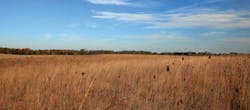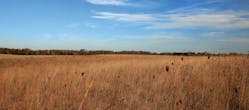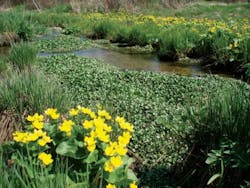Aging infrastructure is on life support in many U.S. cities, unable to handle large storm events that drop millions of gallons of water, leading to dangerous flooding, sewer overflows, basement backups and public health and safety concerns. At the same time, suburban sprawl continues to consume more and more green space, which in turn creates more impermeable surfaces that do not absorb rainwater and snow melt.
According to the Wisconsin Wetlands Association, 270 million gallons of natural flood storage capacity has been lost due to destroyed wetlands throughout the state. The result is an elevated flooding risk for neighbors downstream and more excess water flowing into sewer systems. Back-to-back 1% probability storms and damaging floods in 1997 and 1998 prompted the Milwaukee Metropolitan Sewerage District (MMSD) to look at gray and green water issues together, seeking out more natural solutions to compliment its gray infrastructure investments. What the District created morphed into an innovative program, called GreenseamsSM, that aims to reduce flooding risks and polluted stormwater runoff.
An RFP was sent out, and in 2001 The Conservation Fund (TCF) was contracted to run the Greenseams Program. With 25 years of experience, TCF is a non-profit organization with real estate and negotiating expertise that has preserved 6.5 million acres of land and water resources across the country. TCF is top-rated as an American non-profit by Charity Navigator and the American Institute for Philanthropy.
A Model of Green Infrastructure
In a 420 square mile service area incorporating 28 growing communities and 1.1 million people, development pressure is fierce, regardless of a slow economy. MMSD, years ago, recognized that it needed to protect key properties for the good of the region and Lake Michigan. Greenseams was born and soon started preserving land that contains hydric soil and water-absorbing vegetation, the core idea behind the program. All land is acquired through voluntary sales and protected with a permanent conservation easement. Through the partnership with MMSD and The Conservation Fund, the program has become a model of green infrastructure flood management.
Figure 2: Cold water creek with marsh marigolds. Photo: The Conservation Fund.
Since its inception in 2001, 69 properties encompassing over 2,000 acres of land have been preserved under the program. Of the $22 million spent on acquisitions, $8 million has been funded through state and federal programs. The majority of grant funding has come from the Wisconsin Knowles Nelson Stewardship Fund, a state program that facilitates cooperation between the DNR, local governments and private nonprofit organizations by providing 50% matching grants to qualified projects. Greenseams contains the flood management and land preservation priorities held by both the WDNR Stewardship Fund and MMSD, creating a beneficial overlap between the two entities. Other sources of acquisition funding have come from the North American Wetlands Conservation Act and the Wisconsin Coastal Management Program.
How Does the Program Work?
A potential property requires 25 or more acres unless it is adjacent to already preserved conservation areas, parks or municipal open areas. A "Greenseam," terminology coined by MMSD Executive Director Kevin Shafer, defines these lands as linkages throughout the four service area watersheds that collectively work in sync to manage large amounts of water.
While compiling data though a Geographic Information System, or GIS, Applied Ecological Services, Inc. identified properties containing water-absorbing (hydric) soils and pinpointed them as priorities due to the amount of water they could hold. Currently Greenseams properties contain over 1,400 acres of these highly absorbent soils. The National Technical Committee for Hydric Soils defines them as "soil that formed under conditions of saturation, flooding or ponding long enough during the growing season to develop anaerobic conditions in the upper part."
During wet weather events, hydric soils soak up water and slowly release it, and in the process prevent more water from rushing downstream into the City of Milwaukee, where the majority of flooding issues occur. Greenseams properties have an estimated 1.3 billion gallon storage capacity. Trees are another integral piece in the mosaic of the wetland and prairie landscape. "Stormwater trees" break up raindrops and slow rainfall down before hitting the ground, and their deep roots both hold water and decelerate erosion along stream banks. Over 33,000 trees have been planted on Greenseams sites, covering 71 acres of previously converted land. Riparian corridors are the lifeblood of these watersheds. Acquisition of properties along rivers, lakes and streams allows for stream bank erosion control and filtering of runoff pollutants (such as phosphorous and nitrogen) from entering the local waterways.
In order to reach out and educate the community, Greenseams staff held open house meetings, mailed out packets of information to addresses from the GIS database, and personally met with many prospective sellers who were curious about the program. All property owners are offered fair market value for their land. The program does not acquire property through eminent domain; only willing landowners participate.
Partnerships within the community are essential to purchasing these targeted properties. Greenseams staff work with city planners and officials on each potential purchase; most properties are transferred to local units of government or a local land trust for long-term ownership and management after MMSD initially purchases them and retains a perpetual conservation easement.
Other factors affecting priority ranking include Southeastern Wisconsin Regional Planning Commission (SEWRPC) designations, which classify and document environmental corridors, natural areas and isolated habitat parcels. The Wisconsin Department of Natural Resources has designated some sites as part of their larger preservation objectives, and has taken on the responsibility of a few Greenseams properties.
Restoration
Restoration of agricultural land to pre-settlement vegetation not only improves water storage capacity and generally slows the flow of stormwater downstream but also creates a natural habitat for migrating birds and native plants and animals in the area. A portion of the properties Greenseams acquires is in agricultural use at the time of sale, and approximately 400 acres have been restored. Over 280 acres have been planted with wetland and prairie cover, which includes creating shallow wetland scrapes, breaking drain tiles and removing invasive species (such as buckthorn and garlic mustard). A large amount of restoration grant funding comes from the U.S. Fish and Wildlife Service through their Partners for Fish and Wildlife Habitat Agreement, whose goal is to create a diverse habit for waterfowl and nesting birds by creating perennial wetlands and upland prairies. Additional funding sources include the Wisconsin Coastal Management Program, the American Wetlands Conservation Act and other local sources.
Future Projects
Recently the Wisconsin Department of Natural Resources has adopted phosphorous regulations to control pollution in Wisconsin waterways in an effort to slow rampant algae growth. Nitrogen is also a concern due to its ability to create hypoxia, or low concentrations of oxygen, in Lake Michigan. There is not currently a nutrient trading market in Wisconsin, but TCF has a model in the Chesapeake Bay watershed that is being evaluated as a possible model use for Greenseams sites. Future carbon markets are also a consideration; trees are capable of sequestering carbon in large amounts and may be a useful tool.
The Greenseams program has the structure in place and the knowledge to pursue replication in other cities with flooding concerns. While gray infrastructure is part of the answer to present and future water reclamation issues, existing solutions paired with green initiatives like Greenseams have proved to be cost effective for MMSD, creating open space and wildlife habitat while improving the quality of life for those residents living in and around these pristine locales.
About the Author:
Jessica Hrobar is a Project Assistant for The Conservation Fund, based in the organization's Milwaukee field office.





